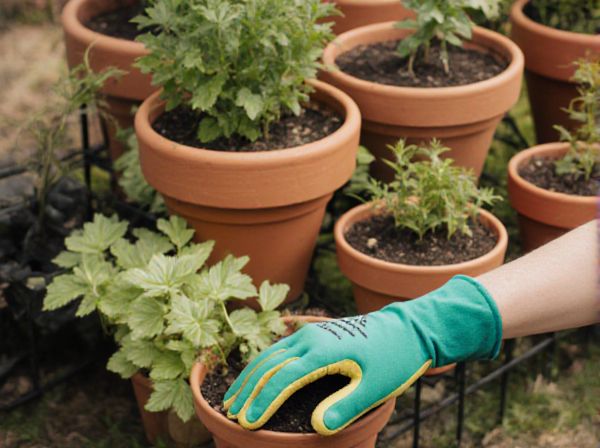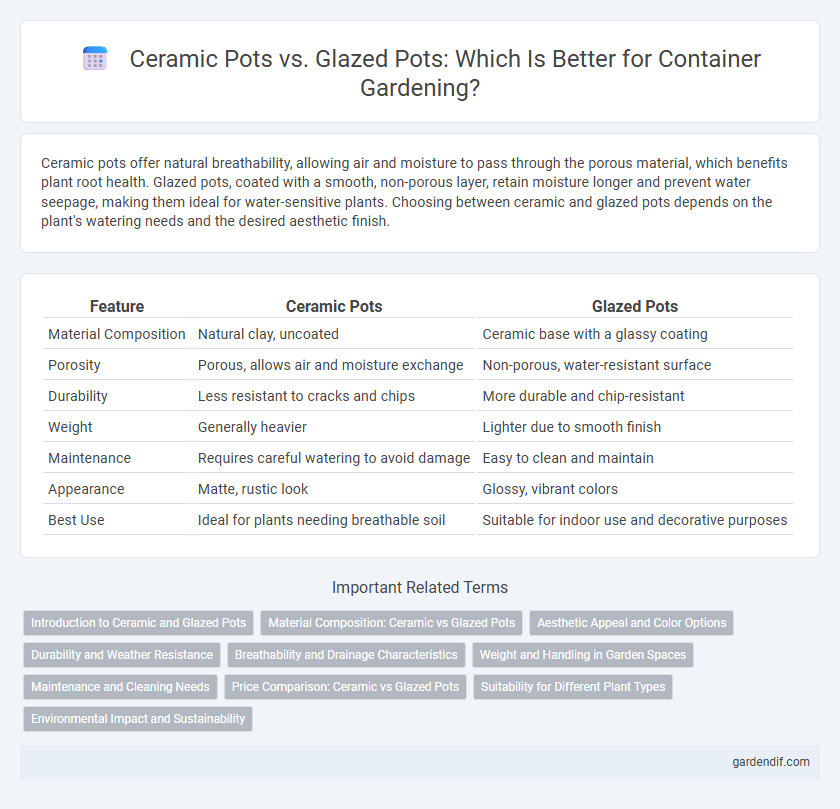
Ceramic pots vs glazed pots Illustration
Ceramic pots offer natural breathability, allowing air and moisture to pass through the porous material, which benefits plant root health. Glazed pots, coated with a smooth, non-porous layer, retain moisture longer and prevent water seepage, making them ideal for water-sensitive plants. Choosing between ceramic and glazed pots depends on the plant's watering needs and the desired aesthetic finish.
Table of Comparison
| Feature | Ceramic Pots | Glazed Pots |
|---|---|---|
| Material Composition | Natural clay, uncoated | Ceramic base with a glassy coating |
| Porosity | Porous, allows air and moisture exchange | Non-porous, water-resistant surface |
| Durability | Less resistant to cracks and chips | More durable and chip-resistant |
| Weight | Generally heavier | Lighter due to smooth finish |
| Maintenance | Requires careful watering to avoid damage | Easy to clean and maintain |
| Appearance | Matte, rustic look | Glossy, vibrant colors |
| Best Use | Ideal for plants needing breathable soil | Suitable for indoor use and decorative purposes |
Introduction to Ceramic and Glazed Pots
Ceramic pots are crafted from natural clay and fired at high temperatures, resulting in a porous structure that allows air and moisture to circulate, promoting healthy plant growth. Glazed pots feature a glass-like coating fused onto the ceramic surface during firing, creating a non-porous, waterproof finish that enhances durability and aesthetic appeal. Both types offer unique benefits, with ceramic pots providing breathability for roots and glazed pots offering superior protection against moisture loss and external elements.
Material Composition: Ceramic vs Glazed Pots
Ceramic pots are crafted from natural clay fired at high temperatures, resulting in a porous, breathable material ideal for plant health. Glazed pots feature a ceramic base coated with a glassy, non-porous glaze that seals the surface, preventing moisture absorption and enhancing durability. The difference in material composition influences water retention and aeration, making ceramic pots better for plants needing well-drained soil, while glazed pots suit moisture-loving plants.
Aesthetic Appeal and Color Options
Ceramic pots offer a natural, earthy aesthetic with matte finishes that highlight organic textures, enhancing gardens and interiors with subtle elegance. Glazed pots provide vibrant, glossy surfaces available in a wide spectrum of colors, allowing for bold visual statements and customization. The choice between ceramic and glazed pots depends on desired visual impact and color preferences in container design.
Durability and Weather Resistance
Ceramic pots offer high durability and excellent weather resistance due to their dense, porous-free composition, making them suitable for outdoor use in varying climates. Glazed pots feature a protective layer that enhances moisture resistance and prevents cracking, but they may chip or wear over time under extreme weather conditions. Both types provide sturdy containers, yet ceramic pots generally outperform glazed ones in long-term exposure to harsh environmental elements.
Breathability and Drainage Characteristics
Ceramic pots offer superior breathability due to their porous nature, allowing air and moisture to circulate freely and promoting healthier root systems. Glazed pots have a sealed surface that limits airflow and reduces evaporation, potentially leading to water retention and root rot. Drainage efficiency in ceramic containers is enhanced by their ability to absorb excess water, while glazed pots rely heavily on drainage holes to prevent water accumulation.
Weight and Handling in Garden Spaces
Ceramic pots typically weigh more than glazed pots, making them less ideal for frequent movement or repositioning in garden spaces. Glazed pots offer lighter weight, which facilitates easier handling and flexibility in arranging plants. The durability of ceramic pots provides stability, but glazed pots balance sturdiness with portability for dynamic garden setups.
Maintenance and Cleaning Needs
Ceramic pots require gentle cleaning with mild soap and water to preserve their porous texture and prevent cracking. Glazed pots feature a smooth, non-porous surface that resists stains and is easy to wipe clean, reducing maintenance time. Both types benefit from avoiding abrasive materials to maintain their finish and longevity.
Price Comparison: Ceramic vs Glazed Pots
Ceramic pots generally cost more due to handcrafted production and natural material quality, while glazed pots tend to be cheaper because of mass-production and added glaze layers that reduce raw material costs. The price difference varies based on size, brand, and design intricacy, with high-end ceramics often commanding premium prices compared to standard glazed options. Choosing between ceramic and glazed pots depends on budget considerations, durability requirements, and aesthetic preferences related to surface finish.
Suitability for Different Plant Types
Ceramic pots offer excellent breathability, making them ideal for succulents and cacti that prefer well-drained soil and less moisture retention. Glazed pots retain moisture more effectively, which benefits tropical plants and those requiring consistently moist conditions. Selecting the appropriate pot depends on the plant's water needs and root aeration preferences for optimal growth.
Environmental Impact and Sustainability
Ceramic pots, made from natural clay and fired at high temperatures, tend to have a lower environmental impact due to their biodegradable composition and longer lifespan compared to glazed pots. Glazed pots often involve additional chemical coatings, which can release harmful substances during production and complicate recyclability. Choosing untreated ceramic pots supports sustainability by minimizing chemical pollutants and reducing waste in landfills.
Ceramic pots vs glazed pots Infographic

 gardendif.com
gardendif.com